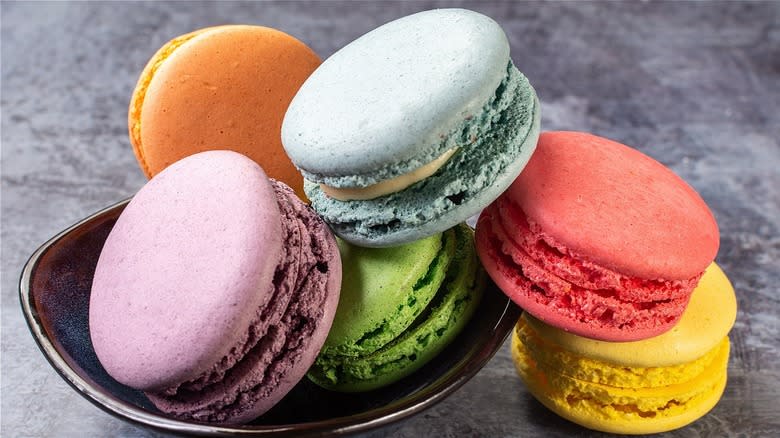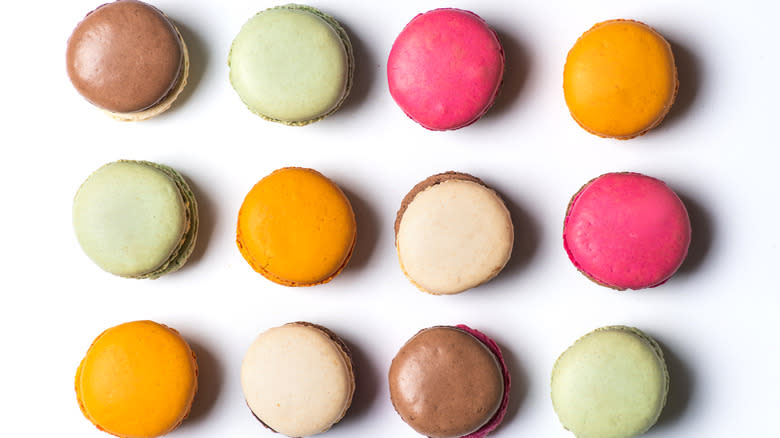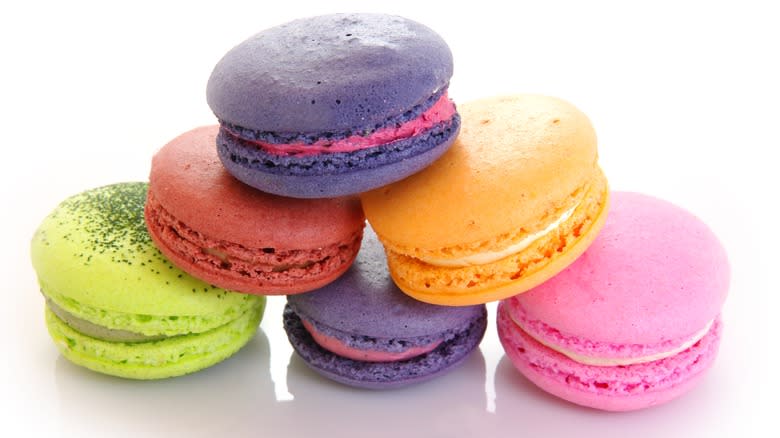French Vs Italian Macarons: What's The Difference?

Macarons -- not to be confused with macaroons -- are sweet sandwich cookies that, though popular throughout the world, are distinctly European. They are composed of two meringue discs with a filling in the middle. The cookies are made with almond flour, so they have a mild almond flavor as a base. Recently, due to their increase in popularity, they can be found in pretty much every color of the rainbow and any flavor imaginable: from peanut butter & jelly to mustard to champagne. Making macarons is a notoriously difficult and time-consuming process, especially for beginners, which is one of the reasons they are such a popular item in bakeries. Macarons have become quite trendy in America, and are offered in bright colors and flavors like mint and salted caramel.
While the origin is disputed, there are two common versions of the macaron: French and Italian. Although both are equally delicious, there is a big difference in the way they are prepared. French macarons use a traditional French meringue, with uncooked whipped egg whites, while the Italian version uses a meringue made with egg whites and hot sugar syrup. French macarons are easier to make, but Italian macarons, though requiring a little more work, are much more stable.
Read more: 13 Store-Bought Ice Cream Bars Ranked From Worst To Best
French Macarons

Macarons have a long and storied, and often conflicting, history. Though most people associate macarons with quintessential Frenchness, it's possible that they actually originated in Italy, and were brought to France after a royal marriage between the nations in the 16th century. Two enterprising 18th-century nuns, the Soeurs Macarons of Nancy, are credited with increasing their popularity with common folk, and a patisserie in the region named after them, the Maison des Soeurs Macarons, still sells macarons according to their original top-secret recipe.
Originally, macarons started out as a single almond cookie. The double sandwich cookie that we recognize today was invented in Paris in the 19th century. This was when a filling such as ganache or jam would be used between the meringue discs. However, there are still regional differences in how the macaron is made throughout France. Patisseries in the Basque region and in St. Emilion make macarons using the original recipe containing almonds and no filling.
The base of all macarons is meringue, which in France is made by whipping uncooked egg whites and sugar into stiff peaks. French macarons have a domed top, flat bottom, and coveted and difficult-to-attain ruffled edges. In order to achieve this look, they are carefully piped onto a cookie sheet and everything, including the weather, determines if they come out perfect or not. The traditional fillings are buttercream or fruit jams though coffee flavor filling was popularized in the early 1980s at a Parisian patisserie.
Italian Macarons

Macarons, or maccherone, have been made in Italy since the 15th century, as crispy-chewy almond cookies, not unlike the amaretti biscuits we're familiar with today. But the modern version, which includes jam, ganache, or filling in the center, wasn't popularized until the 1930s. Out of the three different variations of meringue, Italian meringue is the most stable because a hot simple syrup is incorporated into uncooked egg whites, which cooks them as they are being whisked. This difference in preparation is what distinguishes Italian macarons from the French version and it causes variations in taste, appearance, and texture between the two. Italian macarons are denser, taller, and smoother than French macarons, which are more delicate and powdery.
Because the Italian iteration requires special equipment like a stand mixer and a candy thermometer -- so that the hot syrup can be safely incorporated while making the meringue without overcooking it -- they are generally made in bakeries rather than by home cooks. Classic flavors include raspberry, pistachio, and espresso, of course. These two variations of macarons may look and taste similar but they are a world apart when it comes to preparation and texture.
Read the original article on Mashed.

